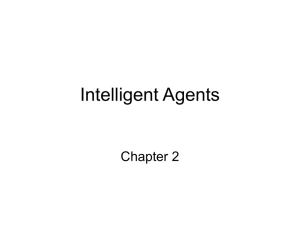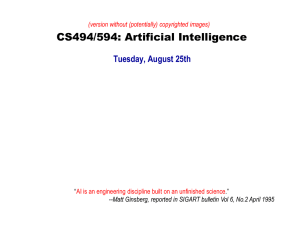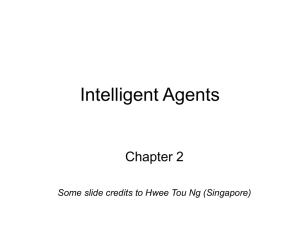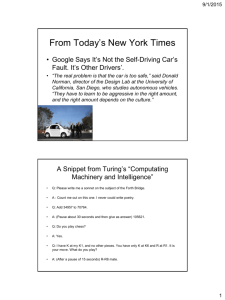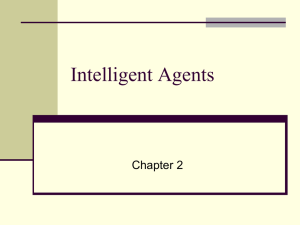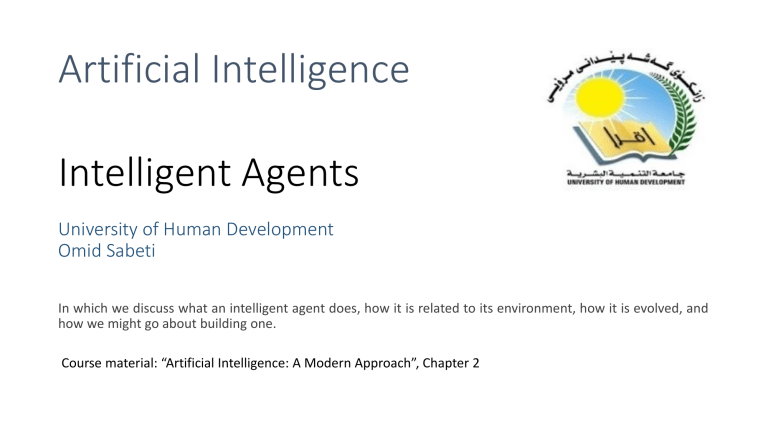
Artificial Intelligence
Intelligent Agents
University of Human Development
Omid Sabeti
In which we discuss what an intelligent agent does, how it is related to its environment, how it is evolved, and
how we might go about building one.
Course material: “Artificial Intelligence: A Modern Approach”, Chapter 2
Outline
`
Agents and environments
`
Rationality
`
PEAS (Performance measure, Environment, Actuators,
Sensors)
`
Environment types
`
Agent types
2
Agents
`
An agent is anything that can be viewed as
`
`
`
Sensors: perceive environment
Actuators: act upon environment
Samples of agents
`
Human agent
`
`
`
Robotic agent
`
`
`
Sensors: cameras and infrared range finders
Actuators: various motors
Software agents
`
`
3
Sensors: eyes, ears, and other organs for sensors
Actuators: hands, legs, vocal tract, and other movable or changeable
body parts
Sensors: keystrokes, file contents, received network packages
Actuators: displays on the screen, files, sent network packets
Agents & environments
`
Agent behavior can be described as an agent function
that maps entire perception histories to actions:
݂ǣܲ כÆܣ
Percept sequence to date
`
Action set
The agent program runs on the physical architecture
to produce f
`
`
Program is a concrete implementation of agent function
Architecture includes sensors, actuators, computing
device
agent = architecture + program
4
Vacuum-cleaner world
`
Percepts: location and dirt/clean status of its location
`
e.g., [A,Dirty]
Actions: Left, Right, Suck, NoOp
`
5
A vacuum-cleaner agent
Tabulation of the agent function
Percept Sequence
Action
[A, Clean]
Right
[A, Dirty]
Suck
[B, Clean]
Left
[ B, Dirty]
Suck
[A, Clean], [A, Clean]
Right
[A, Clean], [A, Dirty]
Suck
…
…
[A, Clean], [A, Clean], [A, Clean]
Right
[A, Clean], [A, Clean], [A, Dirty]
Suck
One simple agent function:
If the current square is dirty then suck, otherwise move to the other square
6
Rational agents
`
"do the right thing" based on the perception history
and the actions it can perform.
`
Rational Agent: For each possible percept sequence, a
rational agent should select an action that is expected
to maximize its performance measure, given the
evidence provided by the percept sequence and
whatever built-in knowledge the agent has.
7
Performance measure
`
Evaluates the sequence of environment states
Vacuum-cleaner agent: samples of performance measure
`
Amount of dirt cleaned up
One point award for each clean square at each time step
`
`
8
Penalty for electricity consumption & generated noise
Mediocre job or periods of high and low activation?
Rational agents (vacuum cleaner example)
`
Is this rational? If dirty then suck, otherwise move to the
other square
`
Depends on
`
`
`
`
9
Performance measure, e.g., Penalty for energy consumption?
Environment, e.g., New dirt can appear?
Actuators, e.g., No-op action?
Sensors, e.g., Only sense dirt in its location?
Rationality vs. Omniscience
`
Rationality is distinct from omniscience (all-knowing with
infinite knowledge, impossible in reality)
`
Doing actions in order to modify future percepts to
obtain useful information
`
information gathering or exploration (important for rationality)
`
10
e.g., eyeballs and/or neck movement in human to see different
directions
Autonomy
`
An agent is autonomous if its behavior is determined by
its own experience (with ability to learn and adapt)
`
`
Not just relies only on prior knowledge of designer
Learns to compensate for partial or incorrect prior knowledge
`
`
`
`
Benefit: changing environment
Starts by acting randomly or base on designer knowledge and then
learns form experience
Rational agent should be autonomous
Example: vacuum-cleaner agent
`
If dirty then suck, otherwise move to the other square
`
`
11
Does it yield an autonomous agent?
learning to foresee occurrence of dirt in squares
Task Environment (PEAS)
`
`
`
`
Performance measure
Environment
Actuators
Sensors
12
PEAS Samples…
`
Agent: Automated taxi driver
`
Performance measure: Safe, fast, legal, comfortable trip,
maximize profits, …
`
Environment: Roads, other traffic, pedestrians, customers, …
`
Actuators: Steering wheel, accelerator, brake, signal, horn,
display
`
Sensors: Cameras, sonar, speedometer, GPS, odometer,
accelerometer, engine sensors, keyboard
13
PEAS Samples…
`
Agent: Medical diagnosis system
`
Performance measure: Healthy patient, minimize costs
`
Environment: Patient, hospital, staff
`
Actuators: Screen display (questions, tests, diagnoses,
treatments, referrals)
`
Sensors: Keyboard (entry of symptoms, findings, patient's
answers)
14
PEAS Samples…
`
Satellite image analysis system
`
Performance measure: Correct image categorization
`
Environment: Downlink from orbiting satellite
`
Actuators: Display of scene categorization
`
Sensors: Color pixel array
15
PEAS Samples…
`
Agent: Part picking robot
`
Performance measure: Percentage of parts in correct bins
`
Environment: Conveyor belt with parts, bins
`
Actuators: Jointed arm and hand
`
Sensors: Camera, joint angle sensors
16
PEAS Samples…
`
Agent: Interactive English tutor
`
Performance measure: Maximize student's score on test
`
Environment: Set of students
`
Actuators: Screen
corrections)
`
Sensors: Keyboard
17
display
(exercises,
suggestions,
PEAS Samples…
`
Agent: Pacman
`
`
`
`
18
Performance measure: Score, lives
Environment: Maze containing white dots, four ghosts, power
pills, occasionally appearing fruit
Actuators: Arrow keys
Sensors: Game screen
Environment types
`
Fully observable (vs. partially observable): Sensors give access
to the complete state of the environment at each time
`
`
`
`
Sensors detect all aspects relevant to the choice of action
Convenient (need not any internal state)
Noisy and inaccurate sensors or missing parts of the state from
sensors cause partially observability
Single agent (vs. multi-agent):
`
`
Crossword puzzle is a single-agent game (chess is a multi-agent one)
Is B an agent or just an object in the environment?
`
`
Multi-agent: competitive, cooperative
`
19
B is an agent when its behavior can be described as maximizing a performance
measure whose value depends on A’s behavior.
Randomized behavior and communication can be rational
Environment types
`
Deterministic (vs. stochastic): Next state can be completely
determined by the current state and the executed action
`
`
`
`
If the environment is deterministic except for the actions of other
agents, then the environment is strategic (we ignore this uncertainty)
Partially observable environment could appear to be stochastic.
Environment is uncertain if it is not fully observable or not deterministic
Discrete (vs. continuous): A limited number of distinct, clearly
defined states, percepts and actions, time steps
`
20
Chess has finite number of discrete states, and discrete set of
percepts and actions while Taxi driving has continuous states, and
actions
Environment types
`
Episodic (vs. sequential): The agent's experience is divided into
atomic "episodes“ where the choice of action in each episode
depends only on the episode itself.
`
`
E.g., spotting defective parts on an assembly line (independency)
In sequential environments, short-term actions can have long-term
consequences
`
`
Episodic environment can be much simpler
Static (vs. dynamic): The environment is unchanged while an
agent is deliberating.
`
`
21
Semi-dynamic: if the environment itself does not change with the
passage of time but the agent's performance score does.
Static (cross-word puzzles), dynamic (taxi driver), semi-dynamic
(clock chess)
Environment types
`
Known (vs. unknown): the outcomes or (outcomes
probabilities for all actions are given.
`
It is not strictly a property of the environment
`
`
Related to agent’s or designer’s state of knowledge about “laws of
physics” of the environment
The real world is partially observable, multi-agent,
stochastic, sequential, dynamic, continuous, (and
unknown)
`
`
22
Hardest type of environment
The environment type largely determines the agent design
Pacman game
`
`
`
`
`
`
`
Fully observable?
Single-agent?
Deterministic?
Discrete?
Episodic?
Static?
Known?
23
Environment types
24
Structure of agents
`
An agent is completely specified by the agent function (that
maps percept sequences to actions)
`
`
One agent function or small equivalent class is rational
Agent program implements agent function (focus of our
course)
` Agent program takes just the current percept as input
`
25
Agent needs to remember the whole percept sequence, if requiring it
(internal state)
Agent Program Types
`
Look Up Table
`
Four basic types in order of increasing generality:
`
Simple reflexive
`
Model-based reflex agents
`
Goal-based agents
`
Utility-based agents
26
Look Up Table Agents
`
Benefits:
`
`
Easy to implement
Drawbacks:
`
space (σ்௧ୀଵ ȁܲȁt; ܲ: set of possible percepts, ܶ: lifetime)
For chess at least ͳͲଵହ entries while less than ͳͲ଼ atoms in the observable
universe
`
`
`
27
the designer have not time to create table
no agent could ever learn the right table entries from its experience
how to fill in table entries?
Agent program
`
Mapping is not necessarily using a table.
`
`
AI intends to find programs producing rational behavior (to the
extent possible) from a smallish program instead of a vast table
Can AI do for general intelligent behavior what Newton did for
square roots?
Huge tables of square roots before 1970s
1.0
1.1
1.2
1.3
...
28
1.00000
1.04898
1.09565
1.14056
function SQRT( double X )
{
double r = 1.0 ;
while ( fabs( r * r - x ) > 10-8 )
r = r - ( r * r - x ) / 2r ;
return r ;
}
Simple Reflex Agents
Agent Program
29
Simple Reflex Agents
`
Select actions on the basis of the current percept
ignoring the rest of the percept history
`
If car-in-front-is-braking then initiate-braking
Blinking reflex
`
30
Simple Reflex Agents
`
`
`
Simple, but very limited intelligence
Works only if the correct decision can be made on the
basis of the current percept (fully observability)
Infinite loops in partially observable environment
31
Model-based reflex agents
32
Model-based reflex agents
`
Partial observability
`
Internal state (based on percept history)
`
`
Updating the internal state information requires two kinds of
knowledge
`
`
`
reflects some unobserved aspects of the current state
Information about how the world evolves (independent of agent)
Information about how the agent's own actions affects the world
Only determine the best guess for the current state of a
partially observable environment
33
Goal-based agents
34
Goal-based agents
`
`
`
Knowing about the current state is not always enough to
decide what to do
Situations that are desirable must be specified (goal)
Usually requires search and planning
`
35
to find action sequences achieving goal
Goal-based agents vs. reflex-based agents
`
`
Consideration of future
Goal-based agents may be less efficient but are more
flexible
`
`
Knowledge is represented explicitly and can be changed easily
Example: going to a new destination
`
`
36
Goal-based agent: specifying that destination as the goal
Reflexive agent: agent's rules for when to turn and when to go
straight must be rewritten
Utility-based agents
37
Utility-based agents
`
More general performance measure than goals
`
`
`
How happy would each world state make the agent?
Utility function is an internalization of performance measure
Advantages
`
`
`
Like goal-based agents show flexibility and learning advantages
Can trade-off conflicting goals (e.g. speed and safety)
Where none of several goals can be achieved with certainty
`
`
likelihood of success can be weighted by importance of goals
Rational utility-based agent chooses the action that
maximizes the expected utility of action outcomes
`
Many chapters of AI book is about this
`
38
Handling uncertainty
environments
in
partially
observable
and
stochastic
Learning Agents
39
Learning Agents
`
`
Create state-of-the-art systems in many areas of AI
Four conceptual components
`
`
`
`
`
Performance element: selects actions based on percepts
(considered as entire agent before)
Learning element: makes improvements by modifying
“knowledge” (performance element) based on critic feedback
Critic: feedbacks on how the agents is doing
Problem generator: suggests actions leading to new and
informative experiences
Performance standard
`
`
Fixed, out of the agent
Percepts themselves do not provide indication of success
`
40
Distinguishes part of the incoming percept as a reward or penalty
Learning Agents
`
`
Learning element is based on performance element (i.e.,
agent design)
The learning element can make changes to any of the
"knowledge" components of previous agent diagrams
`
41
To bring components into closer agreement with feedback
(yielding better overall performance)

